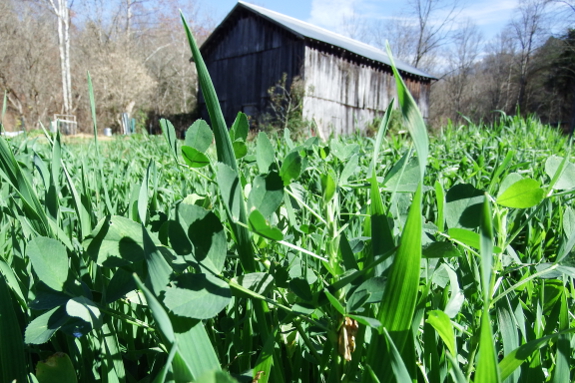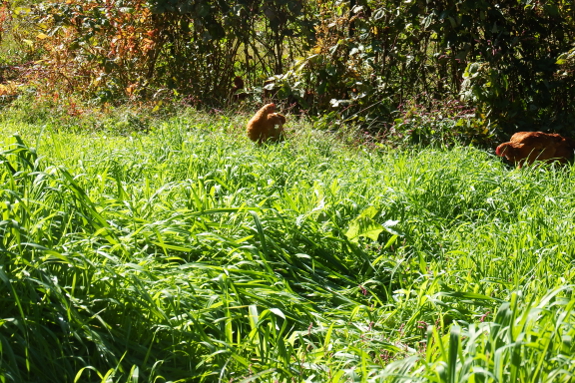
Lawn cropping

Colin Seis and Darryl Cluff are the modern experimenters who have revived the concept of pasture cropping
in Australia. Basically, the idea is to grow grains in existing
pastures without tilling, presumably by first grazing or cutting the
pasture grasses very low during their dormant season, followed by
drilling grains into the stubble. The annual grain is able to grow
faster than the sleepy perennial grasses, but the latter survive well
enough to regrow once the grain produces seed and is harvested.
I have neither excess
pastures nor a wish to grow vast amounts of grain. However, our goats
adore oats as a fall and early winter forage plant. And I also wondered
whether planting oats in some unused corners of our core homestead would
push back the weeds well enough to let me seed other goat-friendly
plants there in later seasons. So in early to mid September, I begged
Mark to weedeat some experimental areas to the ground, I sprinkled on
oat seeds (along with a bit of alfalfa), then I scattered a thin layer
of straw on top to keep birds at bay. Finally, I sat back and I waited.

To my surprise, my
experiment appears to have worked! Now, granted, the oats have grown at
about half the rate of those in well-loved garden beds, which means the
goats turn up their noses half the time at the lawn-grown oats. But if
we don't get a serious cold spell in the next month, I suspect the
slower oats will get stemmy enough to strike Abigail's fancy and that
she'll be glad of the late forage. (If I had it to do over again,
though, I'd plant the lawn oats a week earlier than the garden oats
rather than a week later.)

And we've actually already fed one round of animals via lawn cropping. Our Red Ranger broilers
started expanding their foraging runs into the oat pasture by the time
they were four or five weeks old, which just happened to coincide with
the oats being at their most tender and succulent. As a result, the
grains closest to the brooder were pecked down nearly to the ground,
although the plants quickly bounced back once the broilers were moved to
a grownup coop. I don't know whether its the extra sun this spot gets
or the addition of chicken manure, but these oats are growing twice as
well as the bed I photographed earlier in a no-chicken, shady spot.
The big question now is
--- what will these lawn cropped areas look like come spring? Will the
grasses pop back up, or will the ground be bare enough to try seeding
some soybeans for soil nitrogen and summer goat protein? I'll keep you
posted!
Want more in-depth information? Browse through our books.
Or explore more posts by date or by subject.
About us: Anna Hess and Mark Hamilton spent over a decade living self-sufficiently in the mountains of Virginia before moving north to start over from scratch in the foothills of Ohio. They've experimented with permaculture, no-till gardening, trailersteading, home-based microbusinesses and much more, writing about their adventures in both blogs and books.
Want to be notified when new comments are posted on this page? Click on the RSS button after you add a comment to subscribe to the comment feed, or simply check the box beside "email replies to me" while writing your comment.

Hi Anna and Mark,
It seems to me that you may have hit something big. Letting your animals select the crops that let them grow healthier all without much intervention on your part?
John